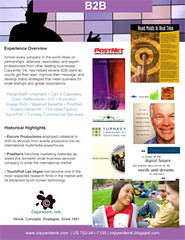Broadcast television is about to change forever and not in the way you might think. Well, maybe in the way you might think, but not in the way some business insiders do. They need to connect the dots.
We immediately saw the writing on the wall last week when
BusinessWeek reported that
YouTube broke the 500 million video views mark in seven months, which is only a chip shot away from overtaking video view leader MSN Video. Most people raced to the site to see what the buzz was about. Even BusinessWeek reporter Rob Hof noted his surprise when YouTube reported serving 30 million video streams per day.
''I assumed they meant 30 million a MONTH,'' Hof wrote. ''Nope, 30 million a day.''
For most people, the YouTube buzz is about offering mainstream shows from the current season (except those with pay-to-view podcasts), clips from TV's earliest days, and homemade movies from around the world. YouTube has even resulted in some aspiring production talents getting placed with big companies and broke a few political foot-in-mouth stories.
On its own, it is hardly earthshaking. Until, you, let's say, take a peek at what AT&T has been up to for months.
In June, AT&T made its
U-verse TV service commercially available to 5,000 homes in San Antonio and the company has said it plans to spend $4.6 billion through 2008 to bring television and high-speed Internet services to almost 19 million homes.
If you don't know about AT&T U-Verse, it's about time you did. Although it's still being perfected, U-Verse provides all-digital television on your TV and home computer at the same time. Of course, that's just the beginning. It also blends in Internet and telecommunications too. In fact, San Antonio already has some 150+ channels to choose from, including local stations.
Connect the dots.
As entertainment turns digital and communications is combined, traditional broadcast producers will see a brand new competitor emerging from the ranks. It might even be you.
You see, right now, YouTube amateurs are just starting to get their acts together. It won't take long before a few ambitious YouTubers begin producing full-length shows beyond the mini-clips and parodies that are currently out there (sure, there are a few already, but I'm talking about the ones people will watch). If they can pull off something that smacks as a pilot, then why not a seasonal series?
How about a few seasonal series? How about an entire network of seasonal series? How about a few news stations too?
If they can do it, and attract a viewership online, how hard do you think it would be for AT&T U-Verse to add a channel with convenient and/or exclusive content to create another unique selling point?
There is no doubt that there exists the potential for independent Web TV producers to forever change the entertainment industry by competing head-to-head with traditional media.
If you don't believe it, then you must not believe some blogs have more readers than international mainstream media (they do) and
Napoleon Dynamite never grossed more than $44.5 million (it did). In fact, Dynamite did it despite not having the one advantage that independent Web TV producers are about to inherit — on-demand distribution.
Simply put, the improvement and development of tools for mass media creativity — camcorders and video editing — gave talented amateurs the opportunity to become overnight producers. And now, the future collaboration of content providers like YouTube and potential Internet distributors like AT&T U-Verse will likely open a whole new world of entertainment, video news, and, yes, even advertising.


















